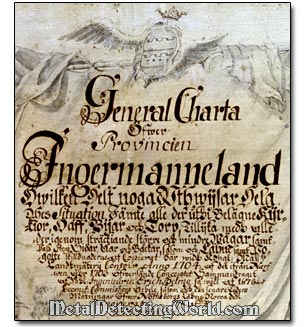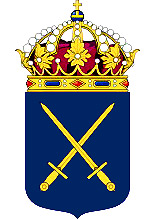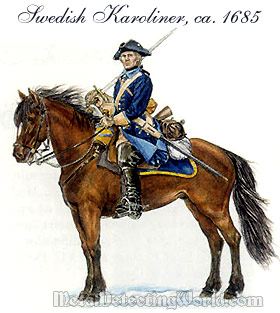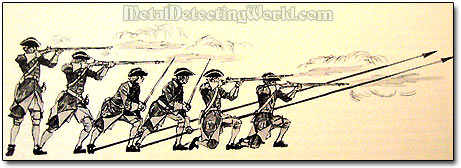Metal Detecting Coins at the 17th Century Swedish Tavern Site (Story 18), p.1
Scrupulous Map Research Always Pays Off: Discovering a "Virgin" Metal Detecting Site in Ingermanland!
by Sergei Upstateny,
Introduction
This story describes a discovery of a "virgin" (untouched) metal detecting site of a Swedish "krog" - a tavern, circa 17th century, located in the eastern Baltic Sea region. This story depicts metal detecting old silver and copper coins at the site with use of different metal detectors.
While writing the story, I thought it would be important to give a reader a brief historical background of the area in focus - western Ingermanland (a historic area in north-west Russia), so I included some historical information, presented in the first four parts of the story, which is to explain the reason why this area is of a special interest to me, and why all coins recovered during this hunt are foreign to this land.
This story is my first attempt to show everyone how much historical and other interesting information can be learned if we research our finds a little - it adds more fun to the treasure hunting process. Newly attained historical knowledge not only expands our horizons and educates us, but also becomes an effective tool, especially when it comes to local history, in developing new tactics, strategies and methods for successful treasure hunting. F.Bacon (1561-1626), an English philosophical advocate and practitioner of the scientific revolution, said it the best: "Knowledge is power!"
The story is rather large in size because of many photographs, over 650(!) of them, that support the story. Below you can find the Table of Story Contents which is to help you in navigating.
TABLE OF CONTENTS:
Part I: Discovering a "Virgin" Metal Detecting Site

- 1) Sweden of 17th Century: Rise to Power with Innovative Military (page 1)
- 2) Dominions of Sweden in 17th Century (p.2)
- 3) Novgorodian Ingermanland and Its Fortified Centers: Brief Historical Facts (page 3)
- 4) Swedish Ingermanland: Brief Historical Facts (page 6)
- 5) A Few Words on Map Research (page 7)
- 6) 1st Hunt - "Hammering" the Site with Minelab Explorer II (page 8)
- 7) 2nd Hunt - Recovering Even More Coins with Minelab E-Trac (page 21)
- 8) 3rd Hunt - Discovering WWI and WW2 Relics (page 30)
- 9) Testing the WW2 Gunpowder (page 35)
- 10) Improving the Target Audio Response and Digging Up More Coins and Relics (page 37)
- 11) Musket Flint Discovery and Flintlock's Brief History (page 41)
- 12) Last Day of Metal Detecting Season (page 43)
Part II: Revisiting Tavern Site
My Articles on Methods That Were Used for Cleaning Coins Shown in This Story:
Sweden of 17th Century: Rise to Power through Innovative Military
One particular category of finds recovered at this location - the coins, more than ever, made a connection to the history of Sweden's conquests in Scandinavia and Baltic Sea region in the 17th century. In the mid-17th century Sweden emerged as a European great power and was the third largest country in Europe by land area, only surpassed by Russia and Spain.

Sweden managed to achieve a great power status due to the ingenious ways to make an effective army. The successful path of innovative military ideas compensated for the lack of manpower and resources. In the early 17th century, the armies of Sweden under Gustavus Adolphus and later Charles X had relatively large success due to the superior tactics used, and foreign mercenaries comprised large parts of the armies.
Gustavus II Adolphus (ruled 1611-1632) was the first Swedish king who revolutionized the Swedish army during the early years of his reign. While other European armies relied on foreign mercenaries, he conscripted and trained his Swedish subjects, thus achieving an organized version of a citizen army. His soldiers developed sufficient discipline to be able to respond to flexible tactics on the battlefield.
To achieve the maneuverability of the battlefield units, he made his infantry men's pikes less unwieldy, shortening them from 16 to 11 feet. He lightened the weight of armor, wearing himself only a leather jacket in battles. And he reduced the number of soldiers in each company in battle formation.
Along with an increased mobility of troops, the artillery was also improved. Under Gustavus' order, the ordnance factories began producing the cast-iron cannons of less than half the weight of any other cannons in the field, but still capable of firing a four-pound shot. Usage of a form of cartridge that held a prepared charge of powder allowed the soldiers to reload the cannon faster than the musket of the day. The field artillery was mounted on carriages which could be pulled by two horses or by a platoon of men.
The battle at Breitenfeld, Germany, in 1631, when Gustavus' army was first seen in action, set a new order of military priority. Fire power and mobility were now the trump cards on the battlefield.
Around 1640, the allotment system - a system used for keeping a trained army at all times, came into use. In 1682, a complete reorganization of the military system was made by the king Charles XI who introduced the new allotment system. Each of the lands of Sweden were to have 1,200 soldiers at disposal, at all times, and two farms were to provide accommodations for one soldier. This system allowed a quick mobilization of the "ready-to-fight" soldiers and was to remain in effect for over 200 years.

At the end of the 17th century, the reformed Swedish army was the largest army in Northern Europe and the only army that did not rely only on enlisted soldiers, mercenaries or conscripted soldiers.
The soldiers of Charles XI were known as Caroleans (Karoliners) and were trained to be skilled and to prefer attack to defense: a carolean could not retreat, only attack or fall. Savaging and looting was strictly forbidden.
The high level of organization and morale made it possible to base the combat tactics on close combat, rather than long-range shooting. This tactic would often result in a fleeing enemy force, which probably stood terrified when their opponent's companies were not stopped by continuous musket fire, but kept marching on towards them in sinister silence.
Also the Carolean tactics almost exclusively relied on very aggressive shock tactic as the infantry and cavalry charged the enemy. When the bayonet was introduced, the pike was discarded in all European armies except the Swedish and Russian by 1700.
In close combat, the pikes had the advantage over the bayonets and swords due to their range. The pike was the most effective weapon used to break the enemy lines during the charge and to repulse cavalry.

Swedish Musketeers and Pikemen
Under the command of the king Charles XII, the Caroleans proved to be the most effective military troop in the most battles of the Great Northern War (1700-1721) in which a coalition of numerous states, such as Russia, Denmark, Norway, Poland and Lithuania, successfully contested Swedish supremacy in northern Central and Eastern Europe. The Caroleans achieved several large scale military successes in the beginning of the war, with the battle of Narva in 1700 as a good example of that.
However, later in the war, the Carolean army met its end after a long and disastrous advancement into the Russian inlands. The army lost 35,000 soldiers - 70% of the Swedish main army, to famine, disease and exhaustion during the march. The rest of the Carolean army was crushed by the newly rebuilt and well trained Russian army of Peter The Great (Peter I) during the battle of Poltava in 1709. Sweden lost 200,000 men in the Great Northern War which put an end to the Swedish Empire.